Corrosion Products and Microstructural Evolution of Ordinary Portland Cement and High-Performance Concrete After Eight Years of Field Exposure in Qarhan Salt Lake
Abstract
:1. Introduction
2. Materials and Methods
2.1. Raw Materials and Mix Proportions
2.2. Concrete Specimens and Field Environment
2.3. Sampling
2.3.1. Direct Sampling
2.3.2. Core Drilling Sampling
2.4. Testing Methods
2.4.1. X-Ray Diffraction (XRD) Testing of Samples
2.4.2. Thermal Analysis of Samples
2.4.3. X-Ray Fluorescence (XRF) Analysis of Samples
2.4.4. Scanning Electron Microscopy (SEM) Analysis of Samples
3. Results and Discussion
3.1. Corrosion Failure States of Concrete Under Field Exposure in the Salt Lake
3.2. Analysis of Corrosion Products in Concrete of Different Strength Grades
3.2.1. XRD and TG-DTA Analysis of C25 Concrete
3.2.2. XRD and Thermogravimetric–Differential Thermal Analysis (TG-DTA) of C60 Concrete
3.3. Depth Distribution Law of Corrosion Products in Concrete
3.4. Correlation Between Concrete Corrosion Products and Strength Grade
3.5. Ion Content Distribution in Concrete and Its Influence on Physicochemical Corrosion Products
3.5.1. Chloride Ion Distribution and Chloride Corrosion Products
3.5.2. Sulfate Ion Distribution and Sulfate Corrosion Products
3.5.3. Sodium Ion Distribution and Physical Chloride Corrosion Products
3.5.4. Magnesium Ion Distribution and Magnesium Salt Corrosion Products
3.6. Microstructural Analysis of Corroded Concrete
3.7. Long-Term Physicochemical Corrosion of Concrete in the Qarhan Salt Lake Environment
4. Conclusions
- The concrete corrosion products varied depending on the concrete strength grade. The C25 saw the formation of gypsum, AFm, and magnesium oxychloride hydrate 318, whereas the C60 saw the formation of Kuzel’s salt.
- For the same corrosion products, their content differed based on the concrete strength grade. In the C25, chloro-ettringite, sodium chloride, and Friedel’s salt were more abundant, whereas calcium carbonate and brucite were less prevalent. By contrast, the C60 contained lower amounts of chloro-ettringite, sodium chloride, and Friedel’s salt but had higher quantities of calcium carbonate and brucite.
- The distribution of corrosion products varied with depth within the same concrete strength grade. In the C25, the chloro-ettringite, Friedel’s salt, AFm, sodium chloride, 318 phase, and brucite content decreased with depth, whereas the calcium carbonate content increased. In the C60, the chloro-ettringite, Friedel’s salt, and sodium chloride content decreased with depth, whereas that of brucite and Kuzel’s salt increased. The concentrations of chloride, sulfate, and sodium ions exhibit a decreasing trend with increasing erosion depth in concrete, characterized by higher accumulation at the surface and reduced penetration into the interior. In contrast, magnesium ion concentrations demonstrate an inverse distribution pattern, progressively increasing with depth and forming distinctly different ionic penetration gradients.
- A transformation phenomenon could be observed between the sulfate-induced and chloride-induced corrosion products, which was closely related to the internal chloride ion concentration of the concrete. As the chloride ion concentration increased, the transformation sequence of the sulfate corrosion products occurred in the following order: AFm → Kuzel’s salt → Friedel’s salt → chloro-ettringite.
- Under salt lake conditions, the HPC exhibited superior corrosion resistance compared to the OPC. Moreover, the corrosion resistance improved with increasing concrete strength.
Author Contributions
Funding
Institutional Review Board Statement
Informed Consent Statement
Data Availability Statement
Conflicts of Interest
Abbreviations
| EDS | Energy-dispersive spectroscopy |
| HPC | High-performance concrete |
| OPC | Ordinary Portland concrete |
| SEM | Scanning electron microscopy |
| TG-DTA | Thermogravimetric–differential thermal analysis |
| XRD | X-ray diffraction |
| XRF | X-ray fluorescence |
References
- Liu, L.X. Brief introduction on the study of erosion and prevention of concrete in salt lake and saline soil area of Chaerhan, Chaidamu. J. Build. Mater. 2001, 4, 395–400. [Google Scholar]
- Yu, H.F. State-of-art and development trend in the study of bittern-resisting concrete. J. Chin. Ceram. Soc. 1999, 2, 120–128. [Google Scholar]
- Yu, H.F.; Hua, P.X.; Qu, W.; Sun, W.; Yan, L.H. Field experiment of anti-corrosion reinforced concrete poles in salt-lake area of North-west China. China Concr. Cem. Prod. 2003, 6, 23–26. [Google Scholar] [CrossRef]
- Wang, F.S.; Sun, R.L.; Qin, X.J. Investigation on durability of cement concrete under Qarhan Salt Lake conditions. Bull. Chin. Ceram. Soc. 2002, 4, 16–22+35. [Google Scholar] [CrossRef]
- Calleja, J. Durability. In Proceedings of the Conference of 7th International Cement Chemistry, Paris, France, 22–27 September 1980; Xue, J.; Tang, M.; Lou, Z., Translators; Architecture Industry Press: Beijing, China, 1980; pp. 634–641. [Google Scholar]
- Yu, H.F.; Sun, W.; Wang, J.C.; Qu, W.; Yan, L.H.; Wei, Z.H. On attack product and corrosion mechanism of ordinarily concrete after long-term exposure to salt lakes. J. Chin. Ceram. Soc. 2003, 5, 434–440. [Google Scholar]
- Brown, P.W.; Badger, S. The distributions of bound sulfates and chlorides in concrete subjected to mixed NaCl, MgSO4, Na2SO4 attack. Cem. Concr. Res. 2000, 30, 1535–1542. [Google Scholar] [CrossRef]
- Li, L.; Ma, H.; Yu, H.; Zhang, J.; Cheng, M.; Wu, Z.; Yan, J.; Zhang, L.; Fan, H.; Wang, F. Attack resistance mechanism, uniaxial compressive mechanical properties and meso-simulation of high-performance concrete exposed to brine in salt lake for 10 years. Constr. Build. Mater. 2023, 407, 133520. [Google Scholar] [CrossRef]
- JGJ63-2006; Standard of Water for Concrete. Ministry of Housing and Urban-Rural Development of the People’s Republic of China: Beijing, China; China Architecture Publishing & Media Co., Ltd.: Beijing, China, 2006.
- Yu, H.F. Study on High Performance Concrete in Salt Lake: Durability, Mechanism, and Service Life Prediction. Ph.D. Thesis, Southeast University, Shenyang, China, 2004. [Google Scholar]
- Ma, L.; Yang, A.W.; Liu, Y.F.; Mao, H.; Su, H.; Jiu, S.W. Characterization and analysis of TG and DSC on the thermal dehydration of phosphogypsum and pure gypsum. Appl. Chem. Ind. 2015, 44, 959–962. [Google Scholar] [CrossRef]
- Shi, Z.; Geiker, R.M.; Lothenbach, B.; De Weerdt, K.; Garzón, S.F.; Enemark-Rasmussen, K.; Skibsted, J. Friedel’s salt profiles from thermogravimetric analysis and thermodynamic modelling of Portland cement-based mortars exposed to sodium chloride solution. Cem. Concr. Compos. 2017, 78, 73–83. [Google Scholar] [CrossRef]
- Vieille, L.; Rousselot, I.; Leroux, F.; Besse, J.P.; Taviot-Guého, C. Hydrocalumite and its polymer derivatives. Part 1. Reversible thermal behavior of Friedel′s salt: A direct observation by means of high-temperature in situ powder X-ray diffraction. Chem. Mater. 2003, 15, 4361–4368. [Google Scholar] [CrossRef]
- Chen, Y.D. Thermal Decomposition Patterns of Dolomite and Their Applications. Master’s Thesis, Jilin University, Changchun, China, 2012. [Google Scholar]
- Zhang, T.L. Study on the Carbonation Performance of Fly Ash Cement Stone Based on Quantitative Carbonate Analysis. Master’s Thesis, Chongqing University, Chongqing, China, 2010. [Google Scholar]
- Li, W.J.; Guo, L.; Zhou, X.; Hong, J. Peridynamic simulation of chloride ion erosion in concrete and the influence of mesoscopic parameters. J. Southeast Univ. (Nat. Sci. Ed.) 2021, 51, 30–37. [Google Scholar]
- Li, L.; Ding, S.J.; Li, J.P.; Li, H. Experimental study on chloride ion erosion in concrete components under varying environmental conditions. J. Harbin Inst. Technol. 2016, 48, 28–33. [Google Scholar]
- Gao, R.D.; Zhao, S.B.; Li, Q.B. Deterioration mechanism of concrete under sulfate attack in multi-factor environments. J. Build. Mater. 2009, 12, 41–46. [Google Scholar]
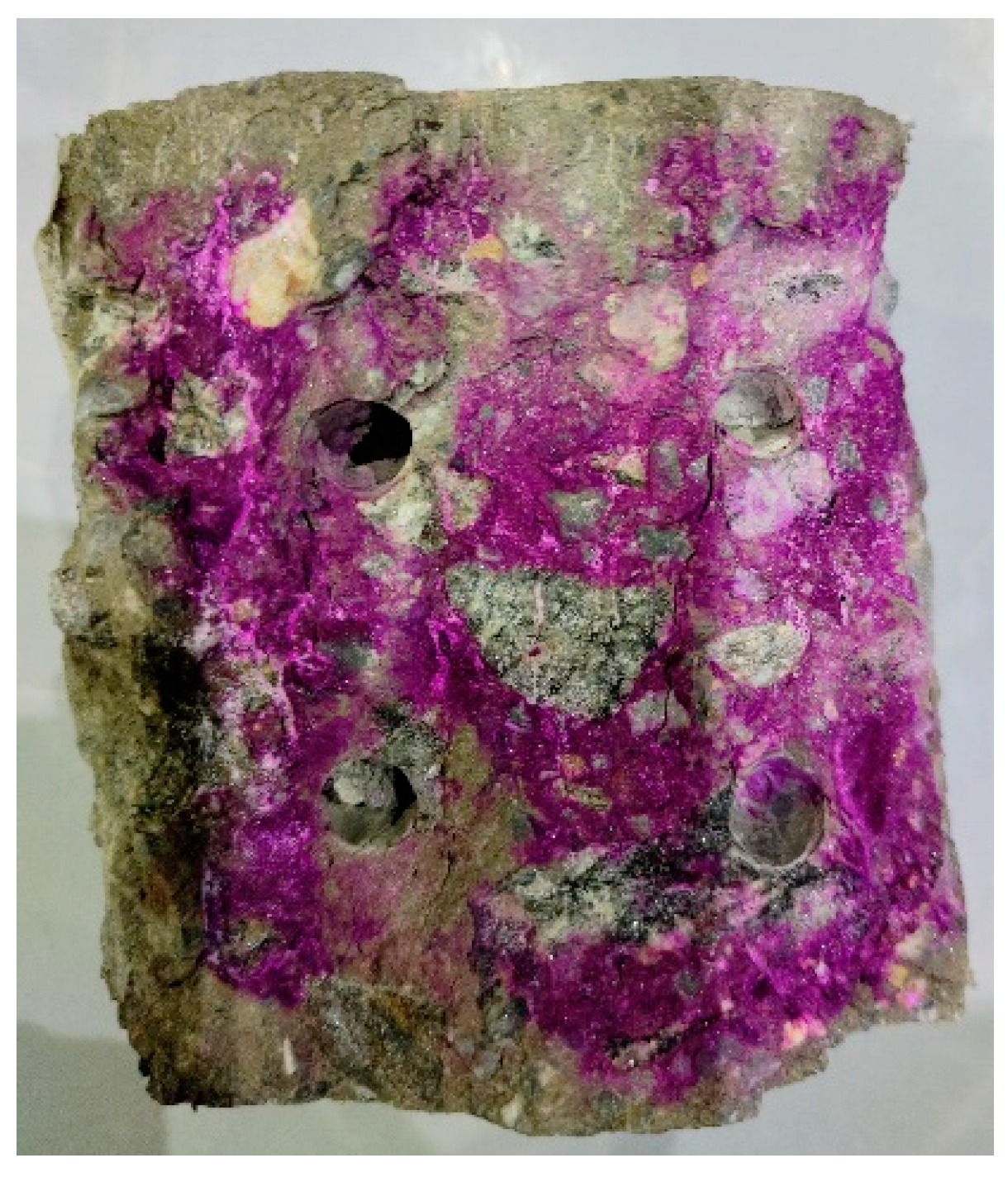

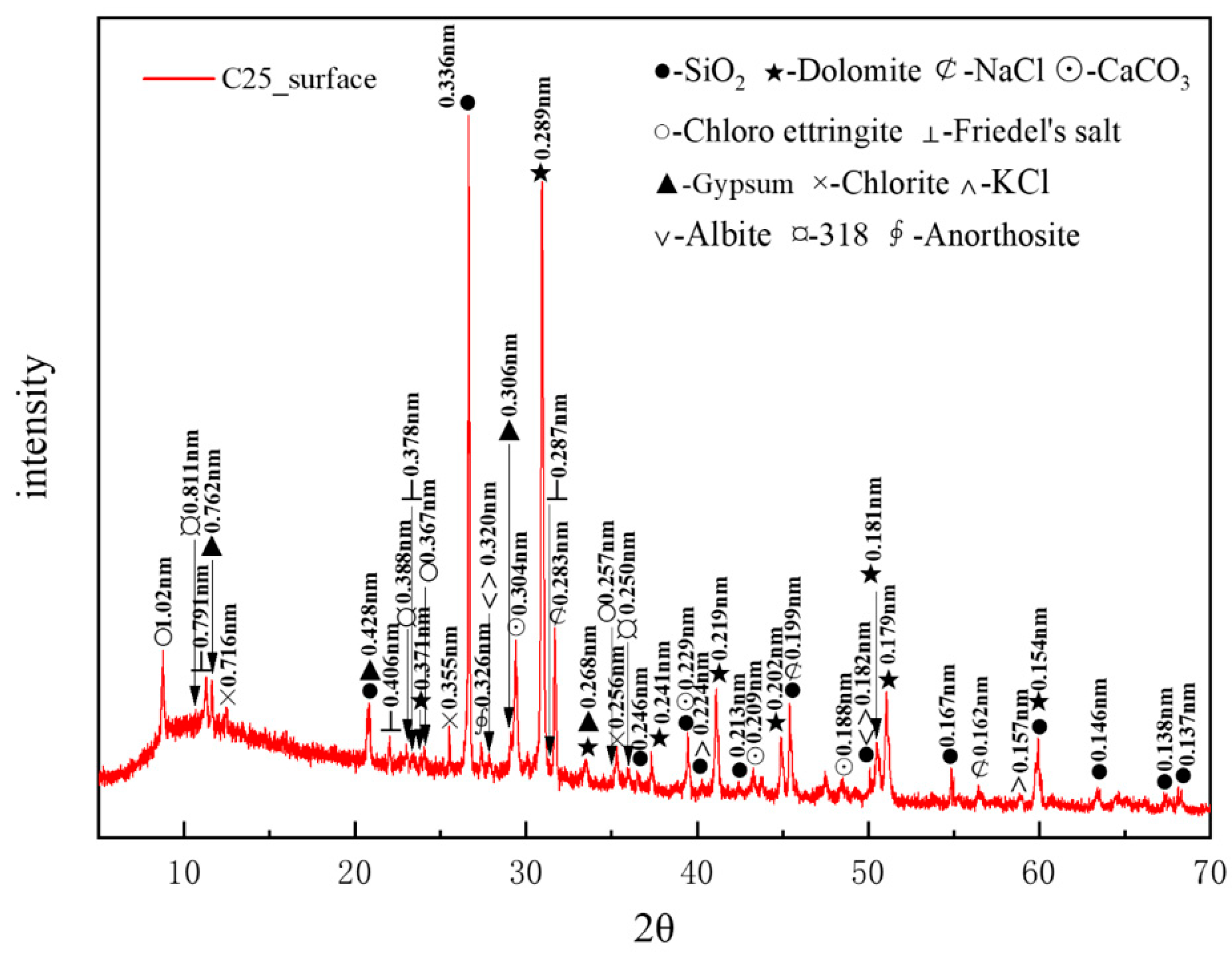


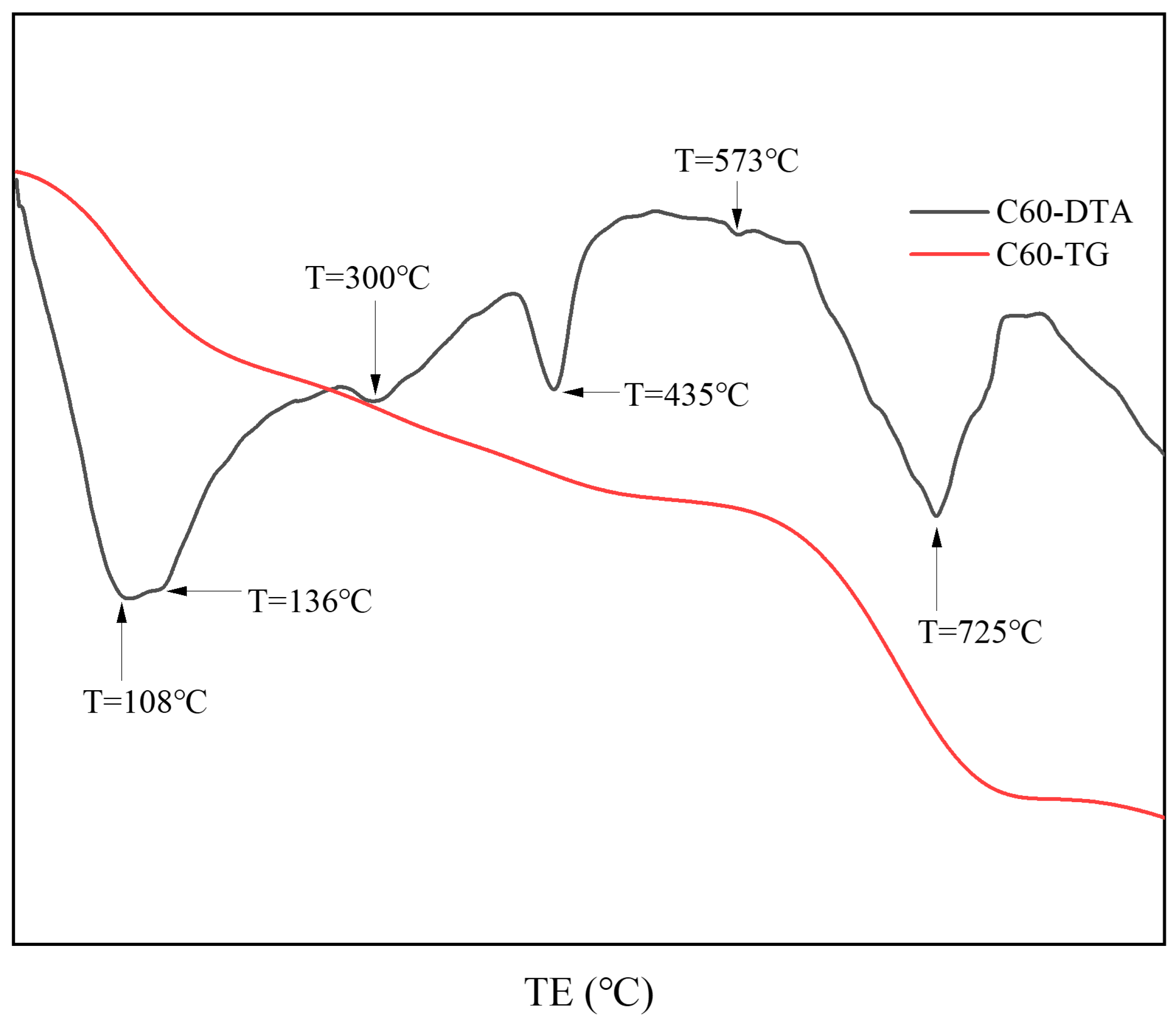
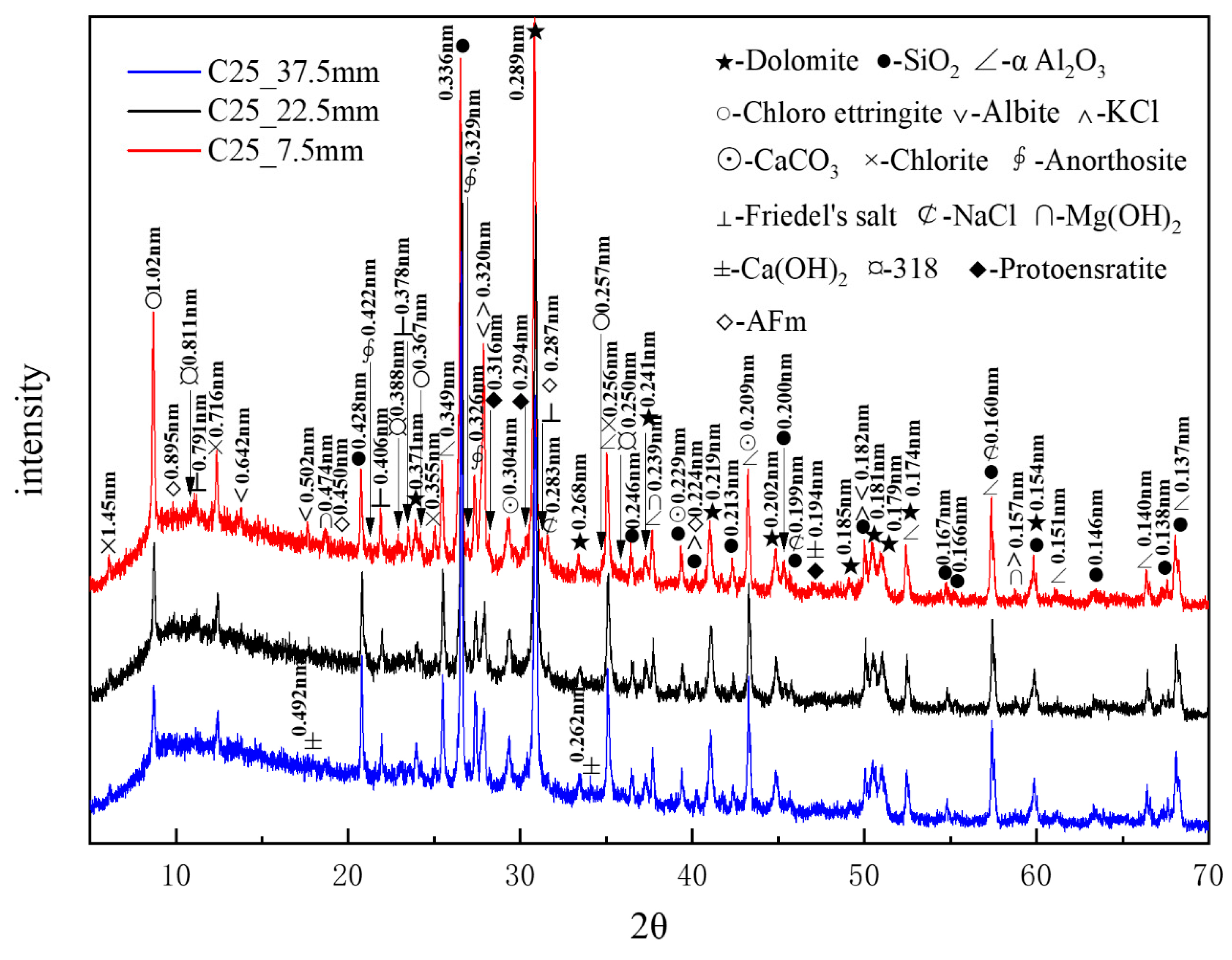
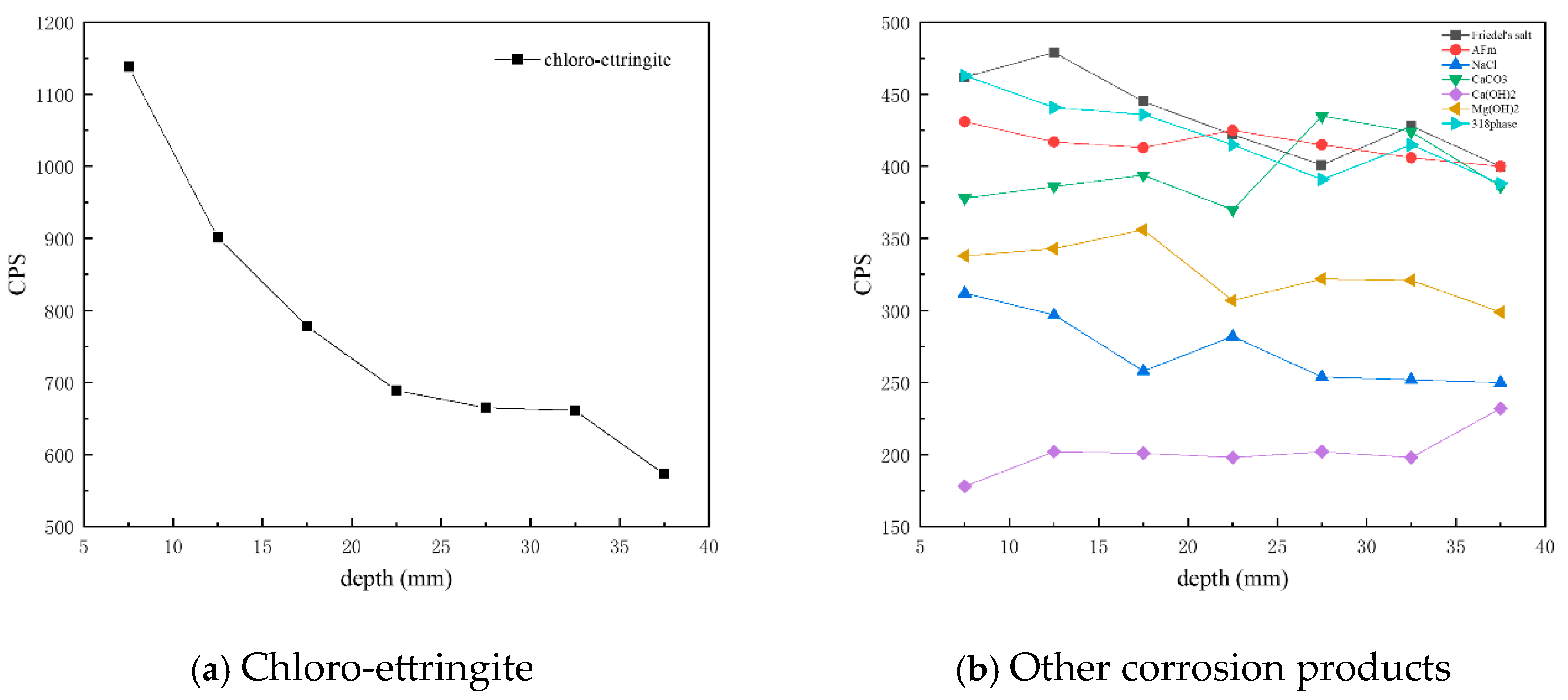
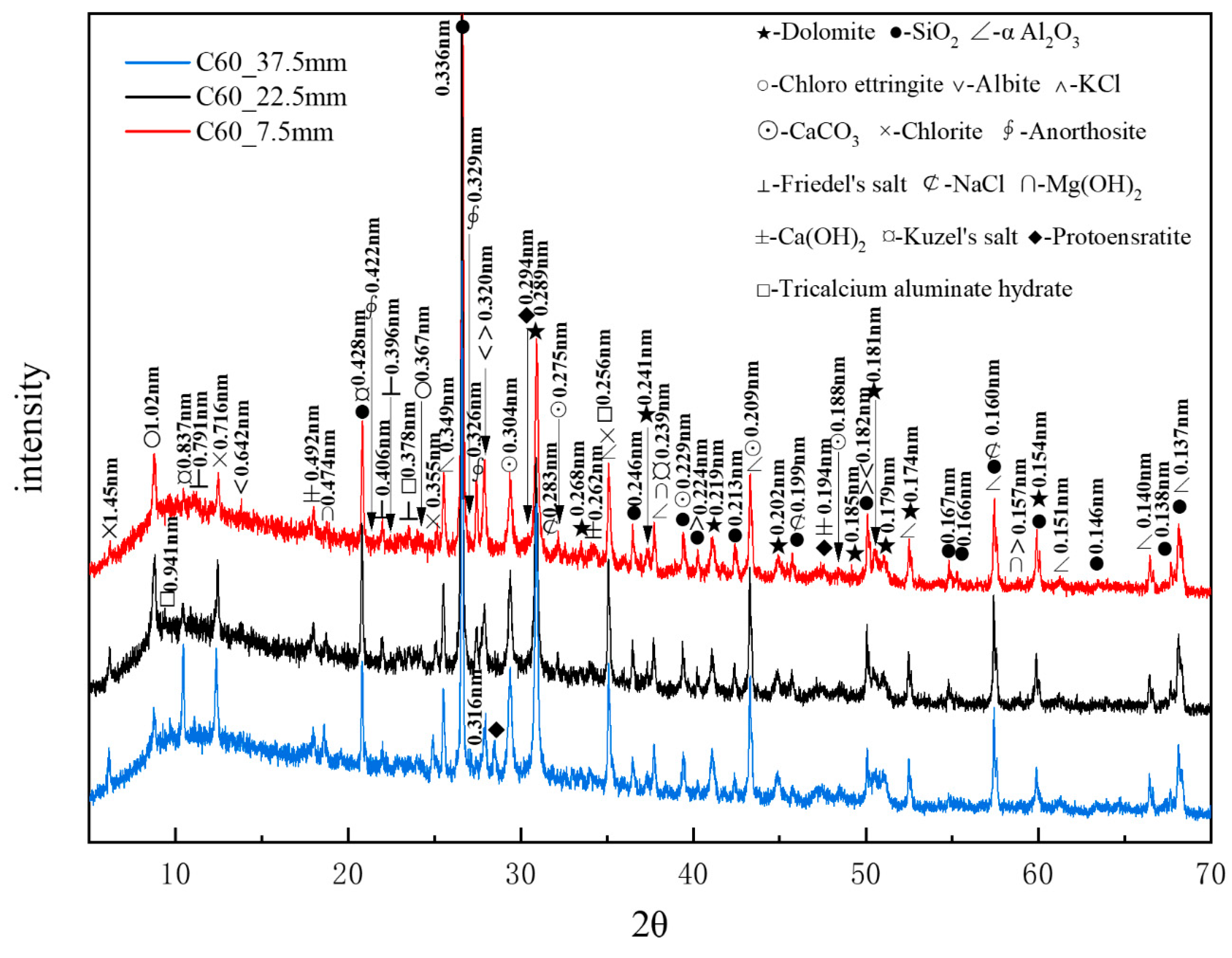
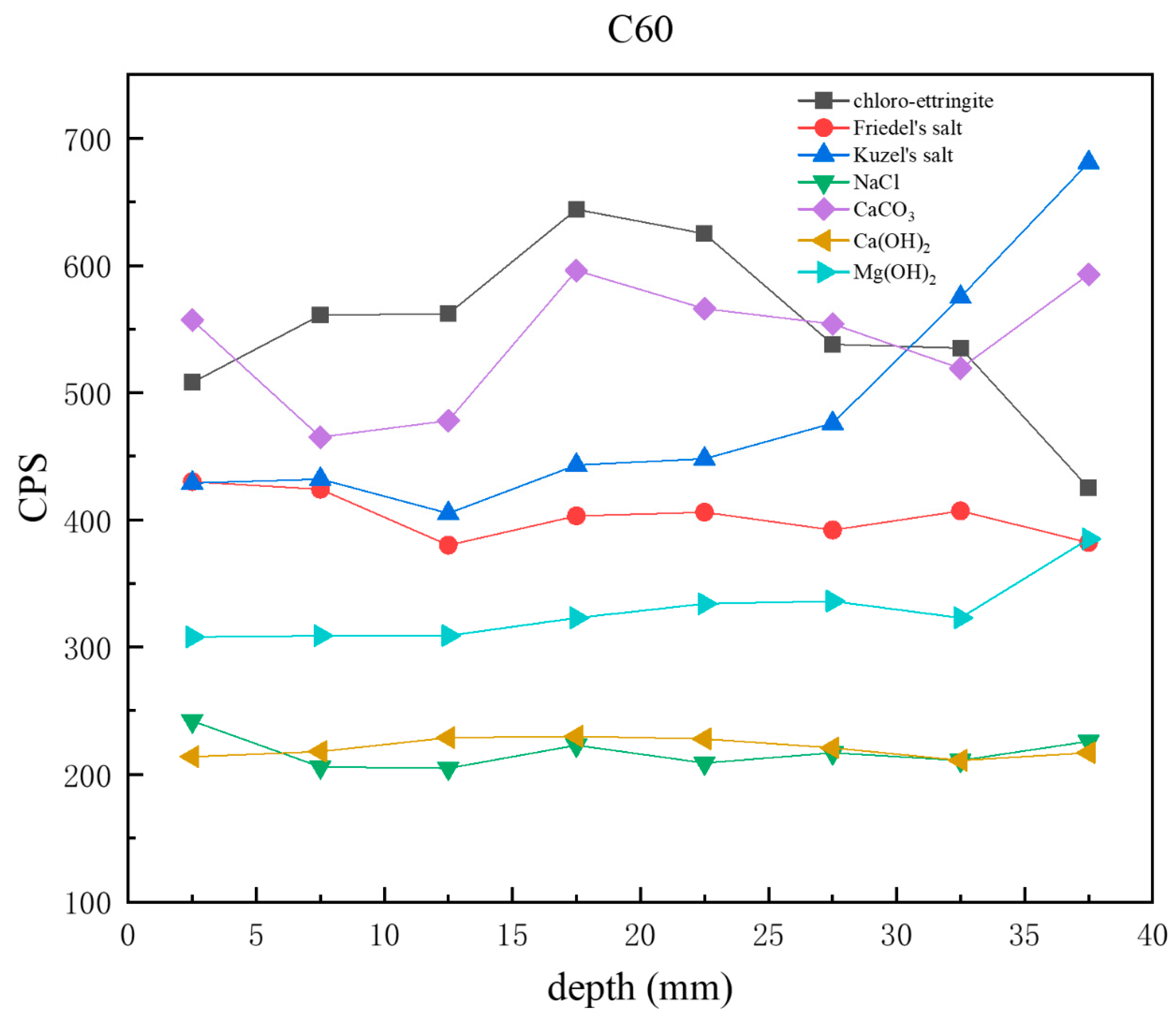

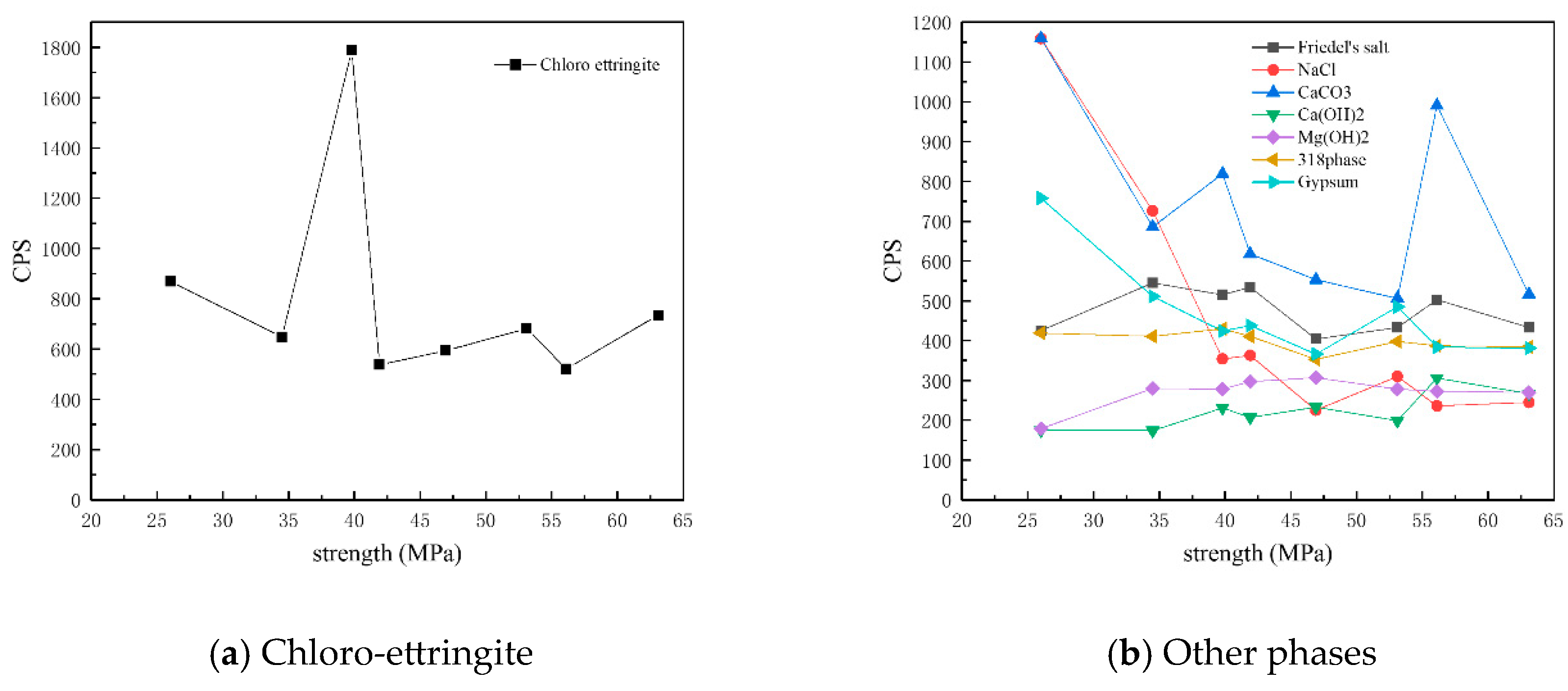
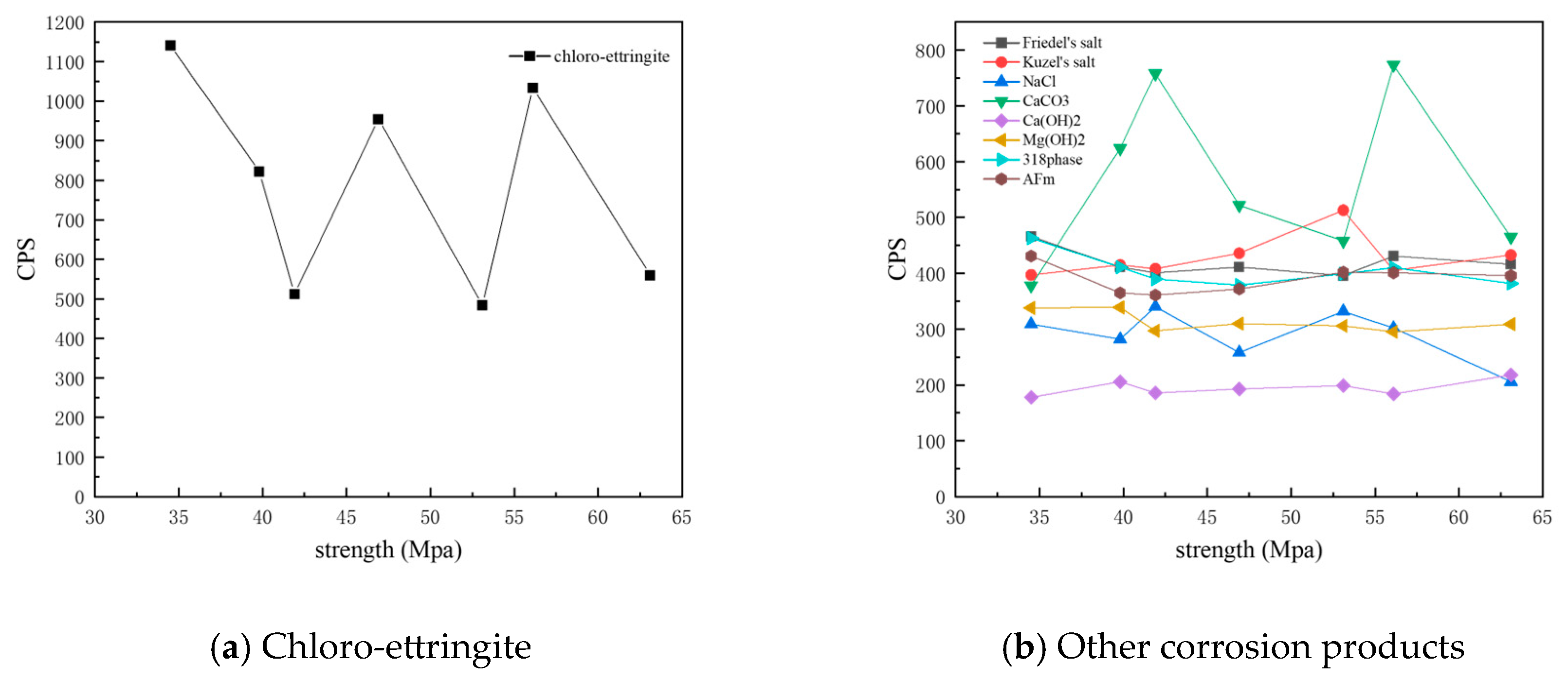
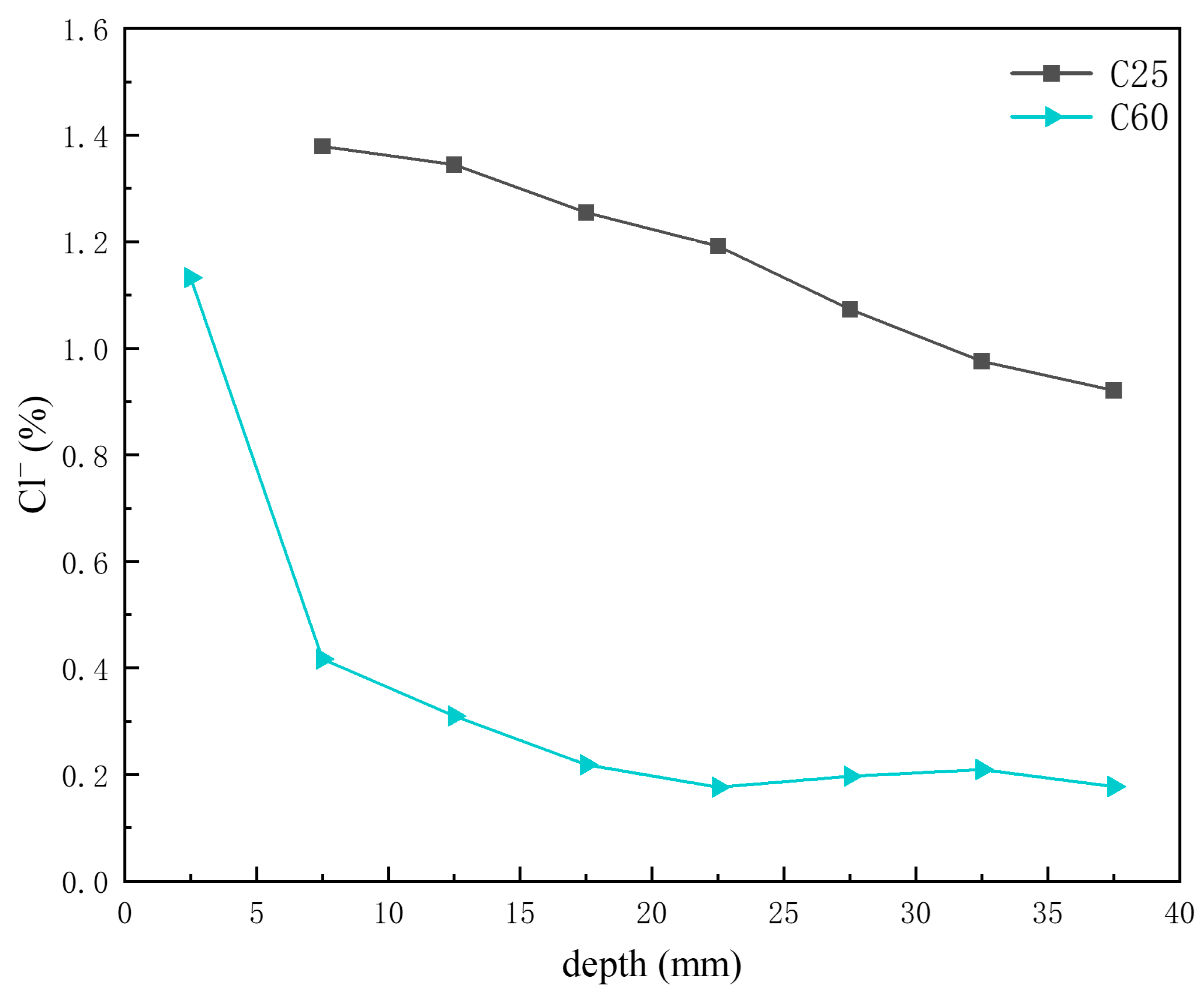
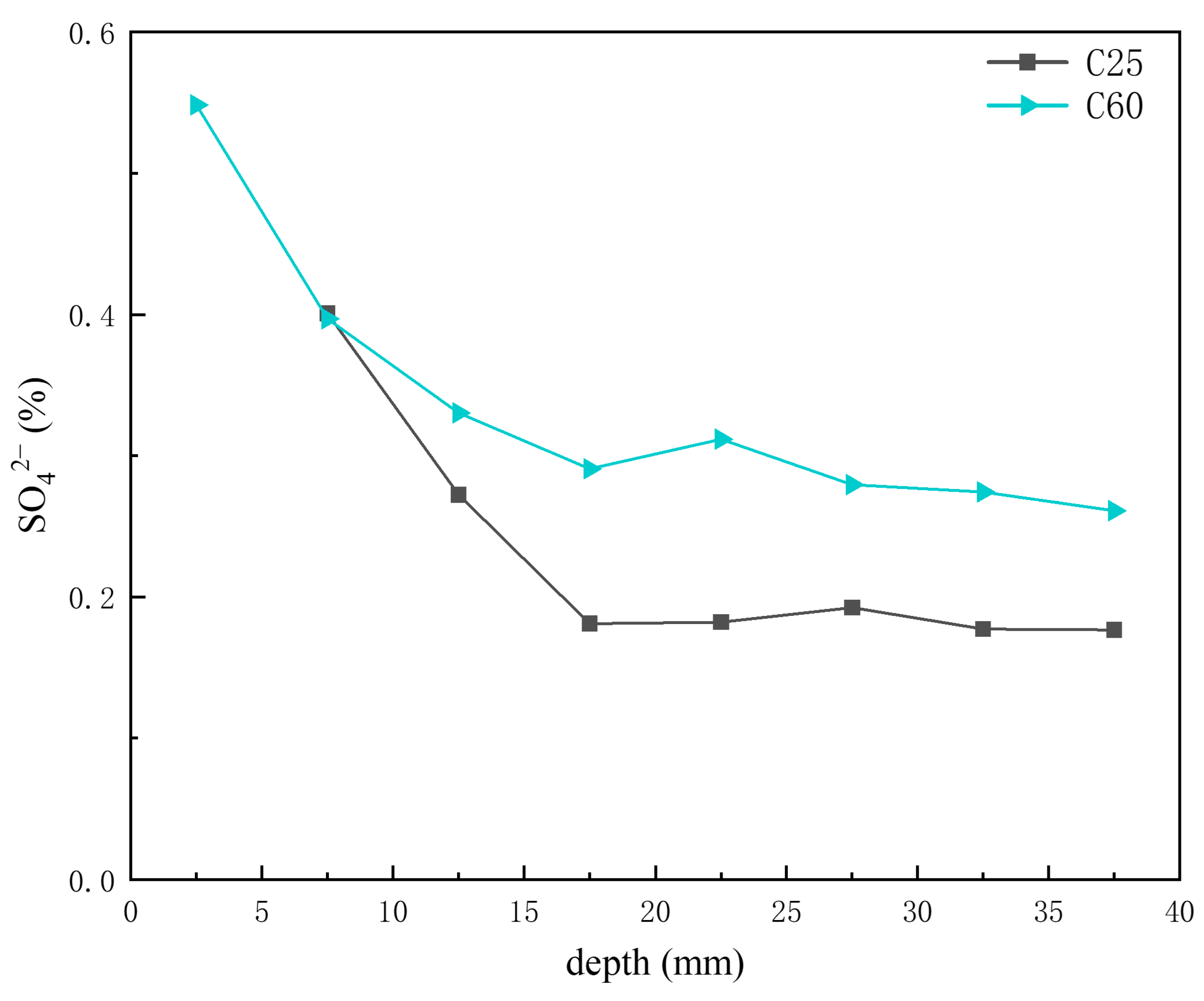
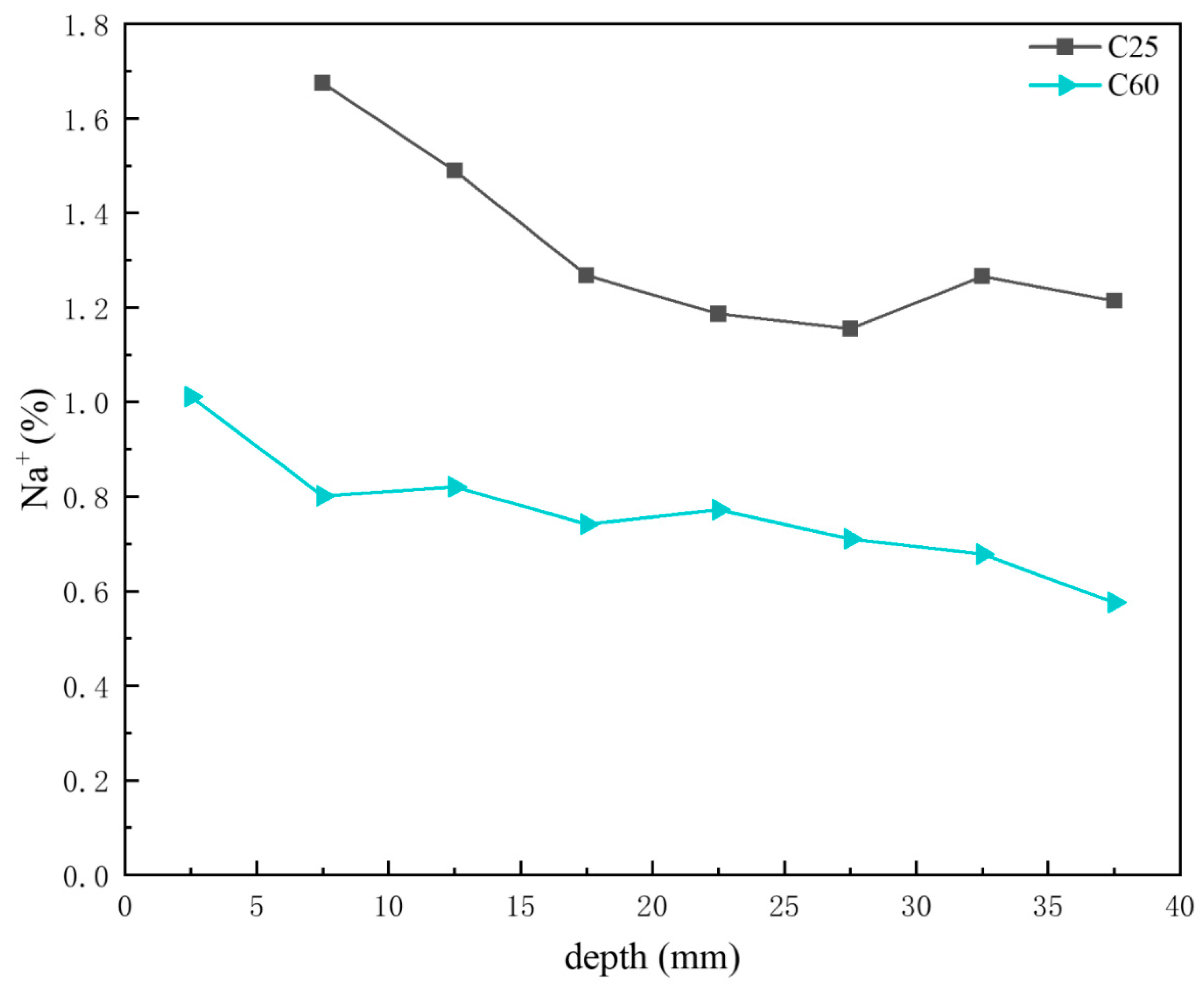

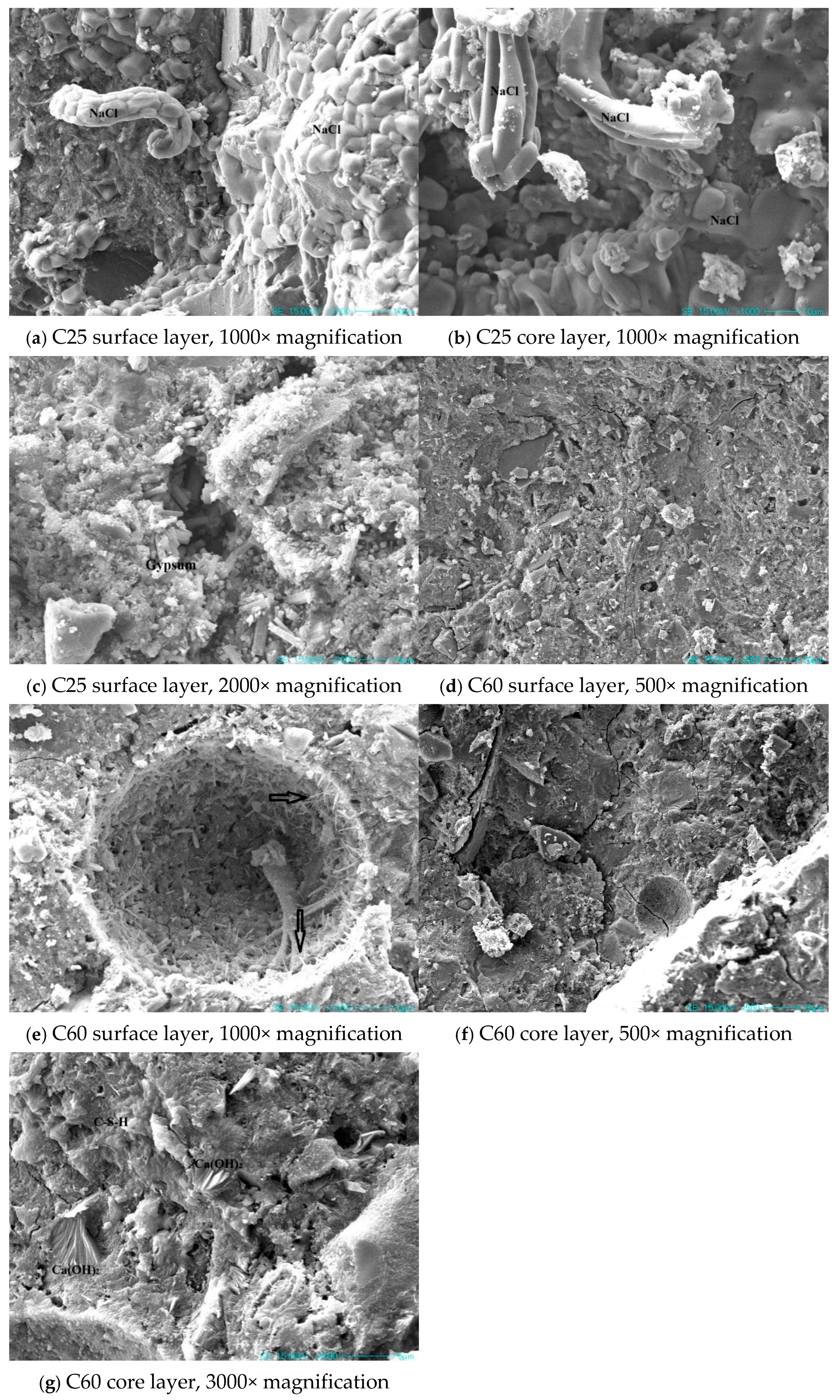
| Model | Fineness | Specific Surface Area/m2 kg−1 | Standard Consistency Water Requirement/% | Coagulation Time/h | Bending Strength/MPa | Compressive Strength/MPa | |||
|---|---|---|---|---|---|---|---|---|---|
| Initial Setting/d | Final Setting/d | 3 d | 28 d | 3 d | 28 d | ||||
| P.II 52.5 | 0.8 | 412 | 25 | 1: 35 | 2: 26 | 5.6 | 9.3 | 26.8 | 57.2 |
| P.O 42.5 | 0.8 | 348 | 26 | 2: 25 | 3: 40 | 5.5 | 7.6 | 21.6 | 48.7 |
| Material | SiO2 | Al2O3 | CaO | MgO | SO3 | Fe2O3 | Na2O | K2O | Cl− | I.L |
|---|---|---|---|---|---|---|---|---|---|---|
| P.II 52.5 cement | 19.56 | 3.78 | 65.88 | 2.42 | 2.41 | 3.69 | 0.50 | 0.82 | 0.022 | 0.94 |
| P.O 42.5 cement | 20.98 | 9.38 | 59.45 | 2.00 | 2.44 | 3.64 | 0.24 | 0.59 | 0.023 | 1.28 |
| Grinding slag | 26.09 | 26.88 | 37.38 | 5.6 | 1.75 | 0.67 | 0.49 | 0.83 | 0.014 | 0.31 |
| Material | Density/g·m−5 | Specific Surface Area/m2·kg−1 | Total Activity/% | Mobility Ratio/% |
|---|---|---|---|---|
| S95 grade mineral powder | 26.09 | 26.88 | 37.38 | 5.6 |
| Aggregate | Apparent Density/kg·m−3 | Stacking Density/kg·m−3 | Void Ratio/% | Sediment Percentage/% | Needle-like Particle Content/% | Crushing Index/% | SO42−/% | Cl−/% |
|---|---|---|---|---|---|---|---|---|
| Fine aggregate | 2647 | 1472 | 38.1 | 5.6 | - | - | 0.11 | 0.0054 |
| Coarse aggregate | 2780 | 1525 | 41.0 | 0.8 | 2.9 | 8.2 | 0.02 | 0.0063 |
| Type | Material/kg m−3 | Water–Cement Ratio | 28 d Compressive Strength/MPa | |||||
|---|---|---|---|---|---|---|---|---|
| Cement | Slag | Sand | Stone | Water | Water Reducer | |||
| C20 | 338 | 605 | 1102 | 195 | 5.41 | 0.58 | 26.0 | |
| C25 | 348 | 70 | 630 | 1114 | 193 | 5.56 | 0.55 | 34.5 |
| C30 | 355 | 82 | 676 | 1130 | 195 | 6.99 | 0.45 | 39.8 |
| C35 | 386 | 98 | 643 | 1143 | 197 | 7.74 | 0.41 | 41.9 |
| C40 | 398 | 105 | 649 | 1155 | 199 | 8.55 | 0.40 | 46.9 |
| C45 | 456 | 105 | 622 | 1156 | 196 | 9.53 | 0.35 | 53.1 |
| C50 | 468 | 120 | 626 | 1162 | 192 | 9.99 | 0.33 | 56.1 |
| C60 | 480 | 135 | 631 | 1168 | 192 | 12.3 | 0.31 | 63.1 |
| Chemical Composition | K+ | Na+ | Mg2+ | Ca2+ | Cl− | SO42− | CO32− | Total |
|---|---|---|---|---|---|---|---|---|
| Mass/% | 0.08 | 10.04 | 0.50 | 3.66 | 17.88 | 0.70 | 4.31 | 37.17 |
Disclaimer/Publisher’s Note: The statements, opinions and data contained in all publications are solely those of the individual author(s) and contributor(s) and not of MDPI and/or the editor(s). MDPI and/or the editor(s) disclaim responsibility for any injury to people or property resulting from any ideas, methods, instructions or products referred to in the content. |
© 2025 by the authors. Licensee MDPI, Basel, Switzerland. This article is an open access article distributed under the terms and conditions of the Creative Commons Attribution (CC BY) license (https://creativecommons.org/licenses/by/4.0/).
Share and Cite
Luo, Z.; Yu, H.; Ma, H.; Tan, Y.; Wu, C.; Sun, J.; Wang, X.; Wu, P. Corrosion Products and Microstructural Evolution of Ordinary Portland Cement and High-Performance Concrete After Eight Years of Field Exposure in Qarhan Salt Lake. Materials 2025, 18, 1769. https://doi.org/10.3390/ma18081769
Luo Z, Yu H, Ma H, Tan Y, Wu C, Sun J, Wang X, Wu P. Corrosion Products and Microstructural Evolution of Ordinary Portland Cement and High-Performance Concrete After Eight Years of Field Exposure in Qarhan Salt Lake. Materials. 2025; 18(8):1769. https://doi.org/10.3390/ma18081769
Chicago/Turabian StyleLuo, Zhiyuan, Hongfa Yu, Haiyan Ma, Yongshan Tan, Chengyou Wu, Jingnan Sun, Xiaoming Wang, and Peng Wu. 2025. "Corrosion Products and Microstructural Evolution of Ordinary Portland Cement and High-Performance Concrete After Eight Years of Field Exposure in Qarhan Salt Lake" Materials 18, no. 8: 1769. https://doi.org/10.3390/ma18081769
APA StyleLuo, Z., Yu, H., Ma, H., Tan, Y., Wu, C., Sun, J., Wang, X., & Wu, P. (2025). Corrosion Products and Microstructural Evolution of Ordinary Portland Cement and High-Performance Concrete After Eight Years of Field Exposure in Qarhan Salt Lake. Materials, 18(8), 1769. https://doi.org/10.3390/ma18081769






